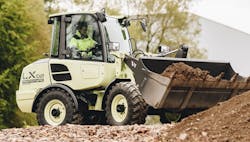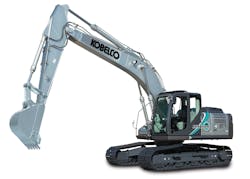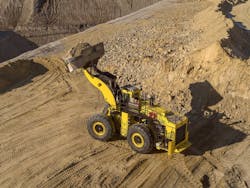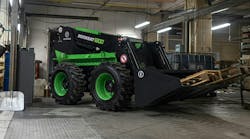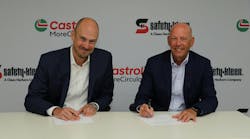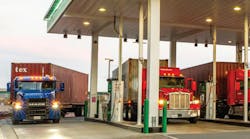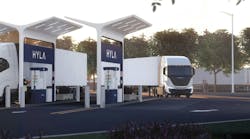That said, in the past decade or so, the auto industry has developed an impressive number of electricity-using vehicles, ranging from “hybrid” models that combine a small engine with electric motors and batteries, to “plug-in” models powered solely by batteries. Although the equipment industry hasn’t received quite the press about advances in electricity-using machines as has the auto industry, its accomplishments are no less notable.
The “electrification” of construction machines might best be observed by citing a number of models exemplifying the process. This overview is not all-inclusive, but intended to show the scope of the process and the design trends emerging. That means many of the technical advances companies such as Liebherr, Hitachi, Caterpillar, and Komatsu are making in electrically based mining shovels and haul trucks will be another discussion, as will the hybrid and bi-energy systems being developed by manufacturers of mobile elevating work platforms.
Among early examples of what might be called a new wave of construction machines using electrically based designs are the Caterpillar D7E crawler dozer, Komatsu HB215LC-1 hybrid excavator, and John Deere 644K Hybrid wheel loader. Construction Equipment conducted field-test evaluations for all three of these machines some years back, and in the Komatsu and Deere tests, ran the hybrids side-by-side with their conventional counterparts.
We came away with a few basic observations: 1) the electrics gave up nothing in the way of power, performance, and operability, compared with their mechanical counterparts, and in some comparisons, the electrics actually had the edge; 2) fuel-savings with the electrics were significant—in one evaluation exceeding 30 percent; 3) dynamic braking and low-rpm torque in the wheel loader was impressive.
The retarding force of dynamic braking allowed V-pattern truck loading with little use of the service brakes and also significantly enhanced controllability on steep downgrades. The hybrid loader was also able to charge the stockpile at relatively low engine speeds (electric motors develop high torque at low speeds), compared with the conventional loader, which needed significantly higher engine speeds to develop the wheel torque (via the converter) to accomplish the same task—consuming more fuel and generating more heat in the process.
Manufacturers developing electrically based machines take different design paths. The Wacker Neuson 803 Dual Power and the Caterpillar 300.9D VPS mini excavators have a small diesel engine that can be shut off if the application has emissions restrictions. The hydraulic system is then supplied from a remote, electrically driven, hydraulic power unit tethered to the machine. A variation on this concept is Takeuchi’s TB216H Hybrid, which has a diesel engine, but also can be powered solely by its onboard electric motor (with its own hydraulic pump group) when tethered to an external power source.
Other compact machines are being developed that “cut the cord,” so to speak. Recently reported, for example, is that Cummins and Hyundai Construction Equipment are jointly developing a battery-powered 3.5-ton excavator that uses Cummins-developed lithium-ion batteries that provide, say the partners, “a full eight hours of operation and a three-hour recharge time.”
Volvo Construction Equipment also has concept compacts powered by lithium-ion batteries: the EX2 mini excavator and the LX2 compact wheel loader. The company has announced plans to have a range of battery-powered compact equipment available by mid-2020.
According to Volvo’s Uwe Müller, program manager, the company also is pursuing a “series hybrid” concept with its LX1 compact loader, which uses a small diesel engine to drive a generator that charges a battery, which, in turn, powers electric motors for the drive hubs and hydraulics. The LX1 has regenerative braking capability, he says, sending electrical energy back to the battery when the machine decelerates or lowers its boom.
Another Volvo concept, the “dual-power” EX1 excavator, can operate with its diesel engine, or can switch to its onboard electric motor (using utility power) to drive all functions. In addition, a concept “autonomous load carrier,” the HX2, is powered via lithium-ion batteries and uses two electric motors for propulsion and a third for hydraulics.
Also in the compact world, reports are that Caterpillar is developing a “zero-emissions” 906 mini excavator using lithium-ion batteries.
A number of companies—among them Komatsu, John Deere, Kobelco, and Caterpillar—have been developing electricity-using machines for some time now and have had time to refine their designs. Caterpillar, for example, recently announced its Next Generation Electric Drive crawler dozer, the D6 XE.
When CE worked with Caterpillar on the D7E field test, the company said the D7E uses an engine-driven generator to produce 480 volts of AC power, which is directed to a power inverter and control system, where it’s changed to 640 volts of DC power. Some of this DC current, regulated at 340 volts, goes to the electrically driven water pump and air-conditioning system, and another portion is converted to “frequency controlled” AC current to drive a pair of AC motors, geared together, in the propulsion module.
Technical advances in the D6 XE, says Caterpillar, include the use of switched-reluctance (S-R) motor technology in place of a permanent-magnet design, resulting in a simpler rotor design, less heat, greater power density, and no need for speed sensors. The D6 XE’s propulsion module uses a single motor instead of the D7E’s two, and a single electronic control module, versus the D7E’s two. Insulation in the motor system supports longer stator life, says the company, and accessory systems are separated from the drive system for simplification.
Komatsu’s HB365LC-3 hybrid excavator, building on the HB215LC-1’s design, uses a generator-motor behind the engine and an electric swing motor that captures swing-deceleration energy via regenerative braking. The captured energy is stored in an ultra-capacitor, which subsequently releases that energy to assist swing motor acceleration during the next cycle. The generator-motor also can use stored energy to rapidly accelerate the engine to meet hydraulic demand and can also charge the capacitor when required.
Kobelco has been developing hybrid excavators since 2006, and the company’s most recent is the SK210HLC-10 Hybrid, the first of the company’s hybrids to use a lithium-ion battery to store energy generated by the electric swing motor during swing deceleration. During high-load operation, energy stored in the battery flows to the swing motor to assist acceleration, as well as to the machine’s generator-motor to assist the engine with powering hydraulic functions. During low-load operation, the generator-motor charges the battery.
Deere’s 644K Hybrid uses an engine-driven AC generator that sends power, via a power-control module, to an AC electric motor, which drives a simplified three-speed power-shift transmission having no torque converter and no reverse clutch. When decelerating, the machine’s kinetic energy drives the transmission motor as a generator, sending power to the engine-mounted generator, which now functions as motor to assist the engine with powering hydraulic functions and with driving the water pump, air-conditioner compressor, oil pump, and alternator.
With the more recent 944K Hybrid wheel loader, Deere has taken a different approach. The machine’s engine drives two electrical generators, which send power to the electric motor positioned at each wheel hub. (Deere prefers to call the generators and motors “electric machines,” since both can function as generators and motors.) A solid-state controller regulates each wheel motor’s torque and speed to prevent a slipping wheel from spinning, dissipating energy, and damaging tires.
When the 944K decelerates, the machine’s momentum drives the four wheel motors as generators, sending power to the controller, then to the generators, turning them into motors that “back-drive” an engine-mounted gearbox that drives hydraulic pumps used for implement hydraulics, steering, and fluid circulation. When the engine is being so assisted, fuel use drops to zero. The 944K does not store energy, and any excess power is dissipated via water-cooled brake resistors. Both the 644K and 944K Hybrids have a four-mode Coast-Control feature, which allows the operator to select the degree of dynamic braking that suits the application.
According to Todd Tuntland, Caterpillar global product application specialist, the Caterpillar 988K XE wheel loader uses a “switched-reluctance electric drive system,” which includes an S-R generator placed between the engine and pump drive. Generator power is sent to an S-R motor attached to a gear box (torque converter and power-shift transmission are eliminated), which sends mechanical power to the axles. Regenerative braking reverses that energy flow, resulting in power generated by the transmission motor being sent (via an inverter) to the engine-mounted generator, now functioning as a motor, which, says Caterpillar, “converts electrical power into mechanical power to drive the engine.”
LeTourneau legacy
Komatsu Mining acquired the P&H wheel loader line with its 2017 acquisition of Joy Global, which had purchased LeTourneau Industries in 2011 and incorporated the LeTourneau loader line into its P&H surface-mining products. These large diesel-electric machines—with bucket capacities to 53 cubic yards—are designed with S-R Hybrid Drive, based on switched-reluctance technology.
Komatsu Mining’s Mark Barr, director, Longview Engineering, explains:
“A switched-reluctance motor, in basic terms, uses a set of electromagnets on its outer, non-rotating portion [the stator] and uses an inner rotating portion [the rotor] made of iron poles. Turn on a set of electromagnets, and a pole is drawn to it; turn off that set and turn on the next set, and the pole is drawn to the next set. Turning the magnets on and off in the right sequence creates a rotational motor.”
In the P&H loader, says Barr, the generator, motors, and braking grids in the drive system are connected to a common circuit called the “DC Bus.” The diesel engine spins the generator, which places energy on the DC bus to power the electric motor at each wheel. During deceleration, the motors become generators, pushing power back onto the DC bus. The engine-driven generator now acts as a large motor, and fuel to the engine is cut off, allowing the generator to power hydraulic systems with “essentially free energy,” says Barr. Excess electrical energy is then stored and used later to propel the machine for a period of time before the engine’s fuel system reactivates.
The company’s Kinetic Energy Storage System (KESS), says Jesse Dubberly, wheel loader product director at Komatsu Mining, was developed to overcome what Komatsu considered disadvantages of using ultra-capacitors as storage devices in the loader application.
“KESS leverages the speed capability of S-R motors with an added mass acting as a flywheel,” says Dubberly. “The energy recovered in braking can be stored for a longer period of time in this flywheel, then pulled out and used at opportune times. KESS can store more than twice the usable energy as an ultra-capacitor and can provide more than six times the power per dollar in a smaller package. For example, the Generation-3 L1350 Hybrid loader, with the KESS charged from braking events, can store up to 1,100 horsepower.”
Summing up, machines using electrically based systems often demand a price premium, compared with their more conventional counterparts, but manufacturers say that fuel savings, reduced maintenance, lower repair/rebuild costs, and, in some instances, added productivity, might offset that initial disadvantage.
